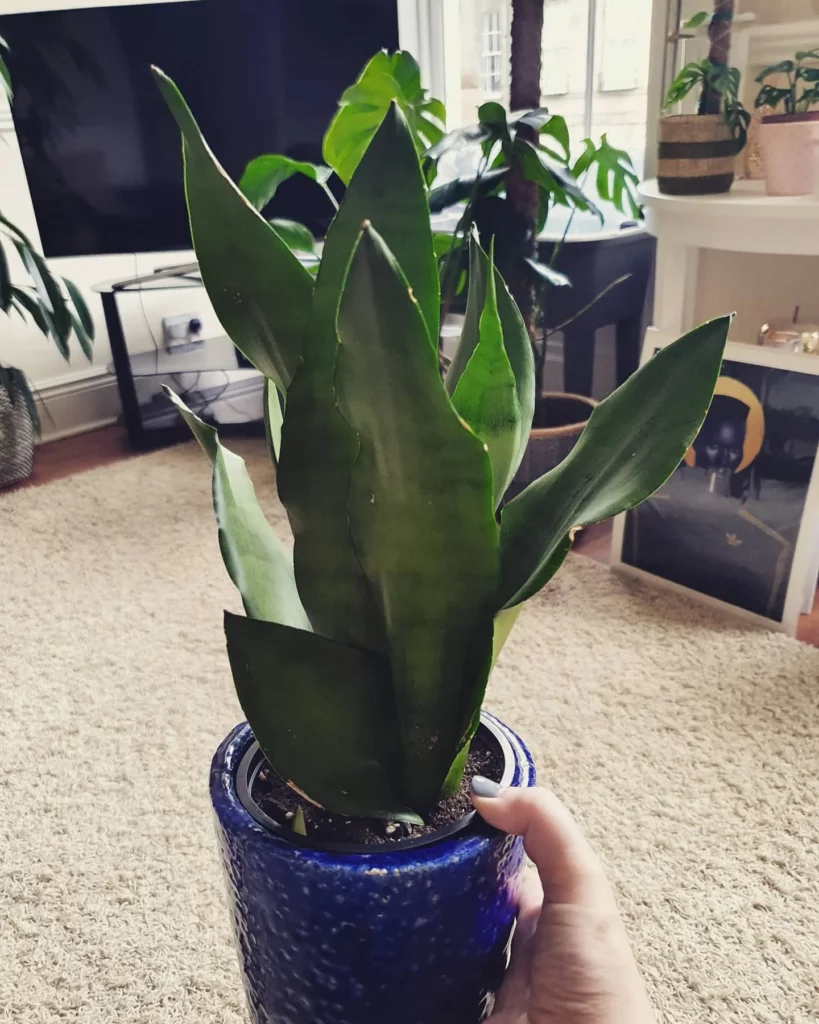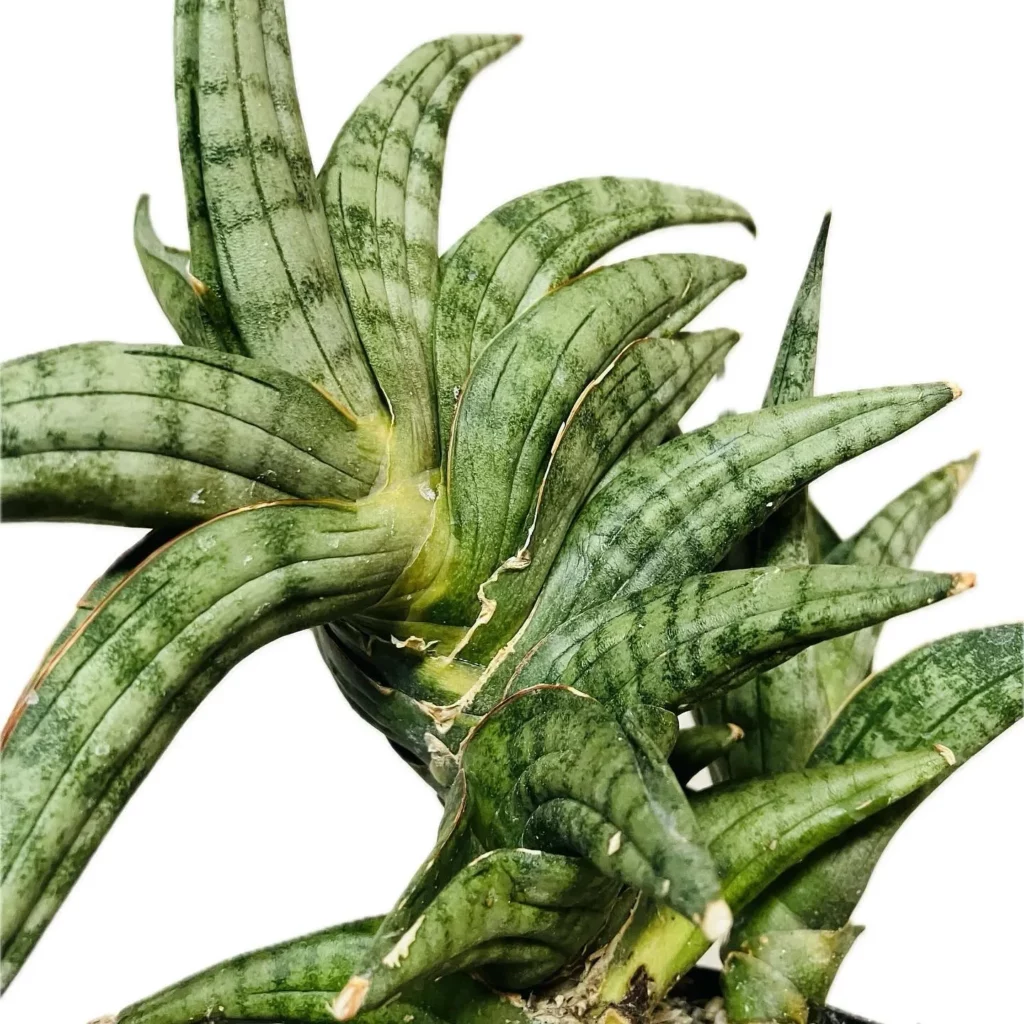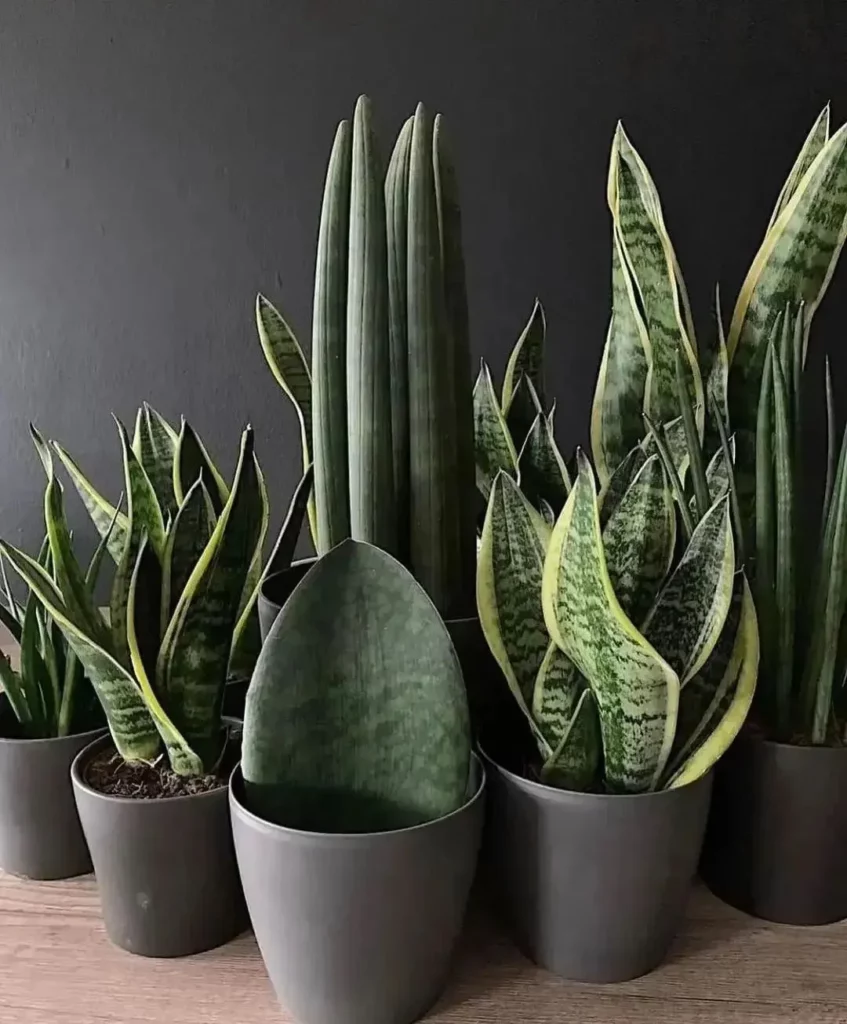To trim a snake plant for optimal health, carefully cut off any brown or damaged tips and leaves with clean, sharp scissors, leaving the healthy green parts intact.
In this concise guide on pruning snake plants, also known as Sansevieria or Mother-in-Law’s Tongue, we’ll cover essential steps for maintaining the health and appearance of your resilient, low-maintenance plant. You’ll learn when and how to effectively remove damaged or dead leaves, control growth, and encourage new foliage, including safe pruning techniques and post-pruning care. Additionally, we’ll discuss how pruning can aid in propagation, helping you expand and share your snake plant collection, making this guide useful for both seasoned plant enthusiasts and beginners.
Why Should You Prune a Snake Plant?



Pruning a snake plant is a beneficial practice that serves multiple purposes. By trimming your snake plant, you can maintain its overall appearance, shaping it into a more uniform and aesthetically pleasing form. Additionally, pruning promotes the growth of new and fuller foliage, enhancing the plant’s lushness and vitality.
No products found.
One significant advantage of snake plant pruning is the removal of damaged, dead, or diseased leaves. This proactive approach helps keep your snake plant healthy and visually appealing, preventing the spread of any potential diseases or pests. By regularly removing unhealthy foliage, you can ensure that your snake plant remains in pristine condition.
When to Trim Your Snake Plant

To ensure the best health and vitality of your snake plant, it’s important to prune it at the right time. The ideal time to trim your snake plant is during its active growing season, which typically occurs in the spring or early summer. This is when the plant is actively producing new foliage and has the energy to recover quickly from pruning.
However, pruning can be done at any time of the year to remove dead, damaged, or diseased leaves. Regularly inspect your snake plant for signs of issues such as yellowing or wilting leaves, brown tips, or overgrowth. If you notice any of these problems, it’s a good indication that pruning is needed.
No products found.
It’s important to note that you should avoid trimming your snake plant during the dormant winter months. During this period, the plant’s growth slows down, and it may not have the resources to recover from pruning. To ensure the health of your snake plant, save the pruning for the active growing season when it can bounce back quickly.
Prep Steps Before Pruning Your Snake Plant



Before you start pruning your snake plant, it’s essential to prepare it properly to ensure the best results. By taking the time to assess your snake plant’s condition and gathering the necessary tools, you’ll set yourself up for a successful pruning session.
Assessing Your Snake Plant
Begin by carefully examining your snake plant’s foliage. Look for any signs of distress, such as wilting, yellowing leaves, brown tips, or overgrown foliage. Identifying these issues will help you determine which leaves need to be pruned and ensure you’re addressing any underlying problems.
Gathering the Pruning Tools
No products found.
To prune your snake plant effectively, you’ll need a few tools. Start by ensuring you have sharp pruning shears or scissors. The sharpness of your tools will make clean cuts, promoting healthier re-growth. Additionally, wear gloves to protect your hands from any potential irritation caused by the plant’s sap. Finally, have rubbing alcohol or a disinfectant solution on hand to sterilize your tools before and after pruning to prevent the spread of disease.
How Do You Prune a Snake Plant Safely?

When it comes to pruning your snake plant, it’s important to follow safe techniques to ensure the health and well-being of the plant. Here are the steps to safely trim your snake plant:
- Start by using sharp and clean pruning tools, such as pruning shears or scissors. This will help you achieve a clean cut and minimize the risk of disease transmission.
- Inspect your snake plant and identify the leaves that need pruning. Look for signs of disease, dead or damaged leaves, yellowing foliage, or excessive growth.
- Before making any cuts, disinfect your pruning tools. This can be done by wiping them with rubbing alcohol or using a disinfectant solution. This step helps prevent the spread of any potential diseases or pests.
- Hold the identified leaf at the tip and gently pull it upward. This will give you better control when trimming. Next, trim the leaf at the soil level, ensuring a clean cut.
- Dispose of the cuttings responsibly. You can either collect them in a compost bin or discard them in the garbage.
Post-Pruning Care for Snake Plants

After pruning your snake plant, it’s important to provide proper care to ensure its smooth recovery and continued health. Here are some essential steps to follow:
1. Protect Fresh Cuts with Cinnamon
Apply a thin layer of cinnamon on the fresh cuts of your snake plant. Cinnamon has natural antifungal properties and can help protect the wounds from infections. This simple step goes a long way in promoting healing and preventing any potential diseases.
2. Adjust the Watering Schedule
Immediately after pruning, it’s crucial to adjust the watering schedule of your snake plant. Allow the plant to settle and avoid overhydration, which could lead to root rot or other complications. Check the moisture level of the soil and water only when needed, ensuring it’s not excessively wet or dry.
3. Avoid Fertilizing for a Few Weeks
Give your snake plant some time to recover before resuming fertilization. Avoid fertilizing the plant for a few weeks after pruning as it needs time to rebuild its energy and focus on healing. Resume the regular fertilizing routine once the plant has shown signs of recovery and new growth.
4. Provide Proper Lighting
Place your snake plant in a well-lit area with indirect sunlight. Adequate light is essential for the plant’s recovery process and overall health. However, avoid exposing the plant to direct sunlight, as it can cause sunburn or other damage to the leaves.
How Long Does It Take for a Snake Plant to Recover from Pruning?

After pruning your snake plant, you may be wondering how long it will take for it to fully recover. On average, a snake plant typically takes about 2-4 weeks to recover from pruning. However, it’s important to note that the exact healing period can vary depending on various factors such as environmental conditions and the overall health of the plant.
During the recovery period, it’s crucial to closely monitor the progress of your pruned snake plant. Observe how the plant responds to the pruning and adjust its care accordingly. Pay attention to new growth and the overall health of the plant’s foliage.
To ensure a successful recovery for your snake plant, continue providing it with the proper care it needs. Place the plant in a well-lit area with indirect sunlight, as it will support the recovery process. Adjust the watering schedule to avoid overhydration immediately after pruning. It’s also advisable to refrain from fertilizing the plant for a few weeks post-pruning, allowing it to focus on healing.
Pruning a Snake Plant as a Propagation Tool

Pruning a snake plant not only helps maintain its health and appearance, but it also presents an excellent opportunity for propagation. Each pruned leaf has the potential to grow into a new plant, allowing you to expand your snake plant collection.
There are two methods for propagating snake plants from leaf cuttings: water propagation and soil propagation. Both methods are straightforward and yield successful results. Let’s explore each method in more detail:
Water Propagation
Water propagation is a popular technique for rooting snake plant leaf cuttings. To begin, select a healthy leaf and make a clean cut at a 45-degree angle. Insert the cut end of the leaf into a glass of water, ensuring that the base is submerged. Place the glass in a well-lit area, away from direct sunlight.
Change the water weekly to keep it fresh. In about 4-6 weeks, you’ll notice the development of roots from the cut end of the leaf. Once the roots are well established, you can transplant the cutting into a well-draining potting mix to continue its growth.
Soil Propagation
Soil propagation is another effective method for propagating snake plants from leaf cuttings. Start by cutting a healthy leaf into sections, each about 2-3 inches long. Allow the cut ends to callus for a day, which promotes root formation.
Prepare a tray or pot with well-drained soil and press the leaf sections gently into the surface, ensuring that the cut ends are in contact with the soil. Water lightly to keep the soil moist, but avoid overwatering. Place the tray or pot in a well-lit area, away from direct sunlight.
In a few weeks, you’ll observe new roots and shoots emerging from the leaf sections. Once they are well established, you can transfer each section into separate pots to continue their growth.
How to Propagate Snake Plant Leaf Cuttings in Water

Propagating snake plant leaf cuttings in water is a simple and effective method to expand your collection of these beautiful plants. Follow these steps to successfully propagate snake plant cuttings in water:
- Select a healthy snake plant leaf for propagation. Look for a leaf with no signs of damage or disease.
- Using sharp and clean scissors, make a clean cut at a 45-degree angle about 2-3 inches from the base of the leaf. This angle helps maximize the surface area for water absorption.
- Fill a glass or jar with water, ensuring that the cut end of the leaf is completely submerged. The water level should be sufficient to cover the base of the leaf, but not the entire leaf
- Place the glass or jar with the leaf cutting in a well-lit area, away from direct sunlight. Snake plants thrive in indirect light.
- Change the water in the glass or jar weekly to keep it fresh and prevent the growth of any harmful bacteria.
- After about 4-6 weeks, you will notice the development of roots from the cut end of the leaf. These roots indicate that the cutting is ready for transplanting into soil to grow into a new plant.
Once roots have formed, carefully remove the leaf cutting from the water and plant it in a well-draining soil mix. Place the cutting in the soil, ensuring that the roots are covered and the leaf is upright. Water the soil lightly and provide indirect sunlight to support its growth.
Snake Plant Soil Propagation from Leaves

If you’re looking to expand your snake plant collection, soil propagation is another effective method to propagate snake plants from leaf cuttings. It’s a straightforward process that can yield new roots and shoots in just a few weeks. Here’s how you can propagate snake plants in soil:
- Cut a healthy snake plant leaf into sections, each about 2-3 inches long. Make clean cuts to ensure the best results.
- Allow the cut ends of the leaf sections to callus for a day. This step is important as it helps to seal the wound and prevent rotting.
- Lay the leaf sections horizontally on a tray or pot filled with well-drained soil. Gently press them into the surface of the soil, ensuring good contact.
- Water lightly to keep the soil moist but not overly saturated. Overwatering can lead to rotting, so it’s important to find the right balance.
- Place the tray or pot in a well-lit area with indirect sunlight. Avoid exposing the leaf sections to direct sunlight, as it may cause them to dry out or scorch.
- Continue to monitor the soil moisture and water as needed. Be patient, as new roots and shoots will start to emerge from the leaf sections in a few weeks.
Snake Plant Pruning: Troubleshooting Common Issues
While pruning your snake plant is a relatively simple task, there are a few common issues that you may encounter. Being aware of these problems and knowing how to address them will help ensure successful pruning and the continued health of your plant.
-
Over-Pruning: One common issue is over-pruning, which can hinder new growth and disrupt the plant’s natural shape. It’s important to exercise moderation when trimming your snake plant, only removing damaged or unwanted leaves while leaving enough healthy foliage for the plant to thrive.
-
Infections and Pests: Fresh cuts made during pruning can leave your snake plant vulnerable to infections and pests. To prevent post-pruning infections, consider applying antifungal powder to the cut surfaces. This will help protect the plant from any potential pathogens and ensure proper healing.
-
Variegated Snake Plants: If you have a variegated snake plant, it’s important to take a more gentle approach when pruning. These plants are often more sensitive to excessive trimming, which can damage the variegation and affect their aesthetic appeal. Take care to only remove leaves that are truly necessary and avoid over-pruning.
FAQs about How to Prune a Snake Plant
Are you unsure about how often to prune your snake plant? Here are some frequently asked questions about snake plant pruning:
- Q: How often should I prune my snake plant?
A: Prune your snake plant every 2-3 years or as needed when it shows signs of overgrowth or leaf damage. Avoid excessive pruning to prevent stress on the plant.
Pruning your snake plant is a crucial part of its care routine. Let’s address some common concerns and provide you with the information you need to keep your snake plant healthy and thriving.
Conclusion
Pruning your snake plant is a simple yet effective way to enhance its overall health and appearance. By selectively removing damaged or unwanted leaves, you can stimulate healthier growth and prevent the spread of diseases. However, it’s crucial to provide proper aftercare, including optimal lighting and watering, to ensure your plant’s successful recovery and thriving. Armed with the right tools and knowledge, you can confidently trim your snake plant and enjoy its natural beauty for years to come.
Remember, maintaining a regular pruning schedule, about every 2-3 years or as needed, will prevent overgrowth and keep your snake plant looking its best. Avoid excessive trimming to minimize stress on the plant and promote optimal growth. By mastering the art of snake plant pruning, you’ll create an aesthetically pleasing and vibrant display in your home or office.
In summary, snake plant pruning is a straightforward process that offers numerous benefits. It not only improves the plant’s health and vitality but also provides the opportunity for propagation, allowing you to expand your collection effortlessly. By following the proper techniques and taking care of your snake plant after pruning, you can establish a strong foundation for its long-term growth and enjoy its resilience and beauty in any space.





